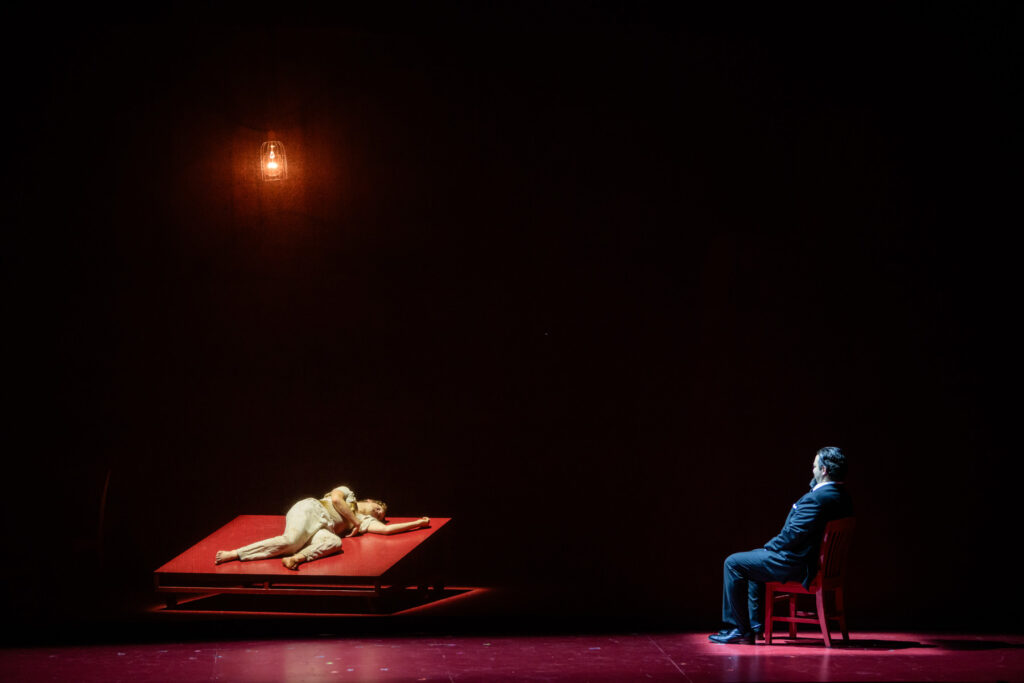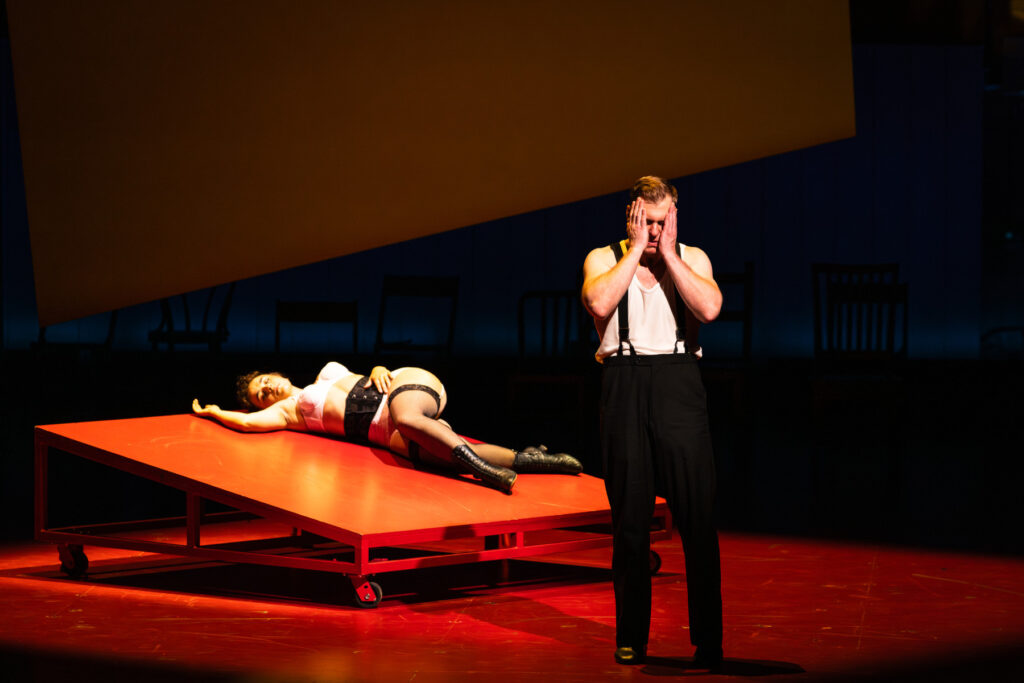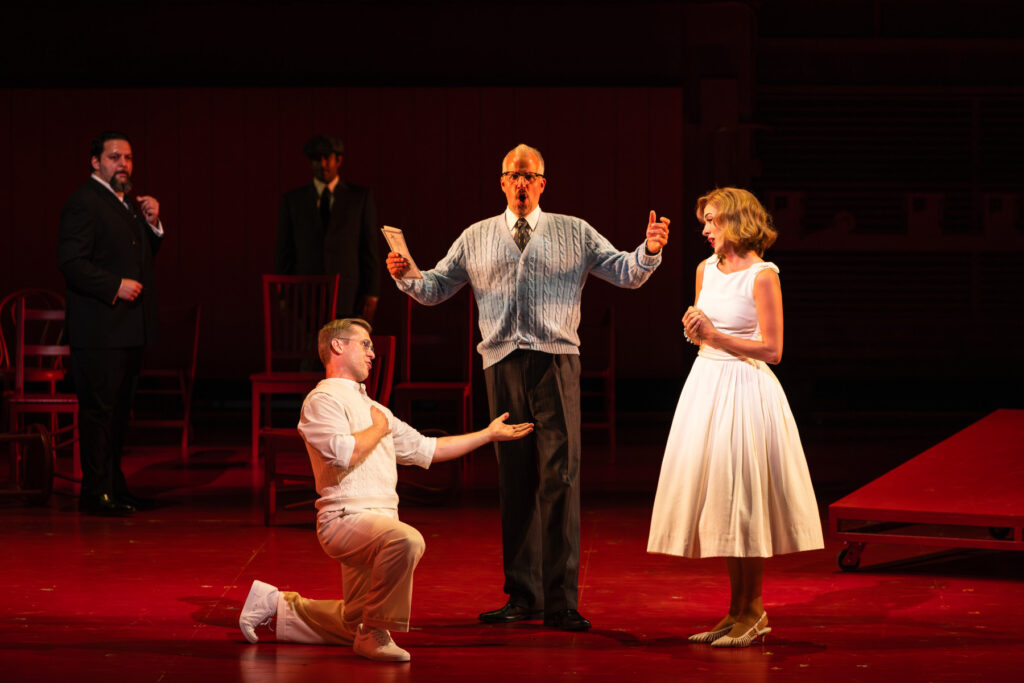If you were expecting a Hogarth-pretty version of Igor Stravinsky, W.H. Auden and Chester Kallman’s The Rake’s Progress at the renowned Glimmerglass Festival, you were at the wrong address.
For Director/Choreographer Eric Sean Fogel and his wildly imaginative creative team have devised a riveting take on this challenging masterpiece, one that is inventively abstract and persuasively surreal, that chillingly reflects Tom Rakewell’s inexorable progress to ruin.
To clue us in on where he was going with the piece, Mr. Fogel’s intended tone was established at the very outset, with Nick Shadow revealed sitting in a chair, placidly watching the inert, insane, bedraggled Rakewell splayed lifelessly on his asylum bed. The imagery told us: Destination, Bedlam.

In short order we were back at the beginning of the tale, in a scenic environment designed by the late John Conklin, as fulfilled by his Associate, James Rotondo. I missed the memo that all four of the productions this season would incorporate the bare back wall of the stage, which at one point or another would be bathed in a blood red color. Many of the set elements were slightly askew, a twisted platform here, a rakishly angled projection screen there, a skewed perspective further over there.
The raising and lowering of various geometric-shaped white surfaces allowed Projection Designer Greg Emetaz free reign to conjure up a cornucopia of images, some startling, others clarifying. The look was as if someone had cut up several Stuart Davis paintings, threw the pieces in a jar, and then randomly pulled them out one by one. The combination of the angular shapes of the set pieces, and the still and moving pictures projected thereon, portended that Rakewell was destined to be a steadily more disordered human being.
Lighting Designer Robert Wierzel was the usual skilled accomplice, flooding the proceedings with all manner of effects including well-considered color washes, atmospheric patterns, and highly effective isolated specials. Lynly A. Sanders provided an accomplished costume design, having great fun with corsets and garters for the brothel scene, balanced by more sedate evening wear, homey looks for the Truelove’s, and rather colorful streetwear for the ensemble. I especially enjoyed the elegant gown for Baba. Together with Hair and Make-up Designer Tom Watson, they made Baba womanly, exotic, and alluring.

Mr. Fogel’s direction was nigh unto impeccable. Indeed, it is arguably among the very finest accomplishments I have seen at this annual festival. The principals were clearly drawn and their relationships expertly delineated. I have rarely seen the ensemble engaged so thoroughly and so physically in the telling of a story. They were very often onstage, sometimes as observers but more often than not, as commentators or participants.
Taking a page from Tommy Tune’s Grand Hotel playbook, there were chairs. Lots and lots of chairs. And the chorus repositioned them endlessly, standing on them, gamboling over them, straddling them, dragging them, upending them, all to punctuate and accentuate the dramatic moment. To add to the intriguing kaleidoscopic stage pictures, Choreographer Fogel has devised some of the most appealingly lithe and athletic movement I have ever seen executed by an opera chorus. For the record, their splendid singing, tutored by Chorus Director Katherine Kozak equaled their awesome theatrical involvement.
Joseph Colaneri led a sterling musical account and elicited a brilliant reading from his accomplished orchestra. Maestro Colaneri inspired distinctive solo work, along with highly polished ensemble passages, especially from a terrific brass section. He also commanded knowing control over his onstage forces, effectively partnering with the fine soloists. I was particularly impressed by Maestro’s meticulous conducting of the stereophonic choral passages in the extended final pages, when the divided singers were placed in the balconies of the house. Chilling effect.

As the Rake of the title, Adrian Kramer was a revelation as Tom Rakewell. I have never heard a ringing tenor of such unerring power and color in this part. Mr. Kramer is also singing spinto roles at this point in his career, and it is easy to see why. His is a vibrant, freely produced, glowing tone throughout the range that easily envelops the house. Moreover, he is capable of great variety and nuance, easily investing his phrases with dramatic truth. And he is youthful and handsome to boot. This was a thrilling star turn so remarkable it may have ruined me forever for wanting to see anyone else undertake. It.
Aleksey Bogdanov was an exemplary Nick Shadow, with a voice so voluminous and imposing that it was probably heard in Binghamton. His laser-focused, darkly tinged delivery was delectably insinuating. His devilishly appealing stage presence was amusingly larger-than-life (at least, “this” life). Mr. Bogdanov offered a fully rounded rogue, one who could cajole and seduce with finesse, but when circumstances provoked his rage, watch out! I have not often heard such raw, pin-you-in-your-seat controlled power. A stunning achievement.
Given the sizable vocal presence of these two, Lydia Grindatto’s Anne Trueloveu faced a gauntlet thrown. The character is not cut from the same cloth, and in an attempt to play her as contrastingly demure and in love, at first I found her vocalizing a little soft-grained. Perhaps it was also her placement mid-stage, but initially she got overpowered in the ensembles. That changed emphatically with “No Word from Tom,” which had her down center, and revealed a much more pointed and spirited delivery. From then on, Ms. Grindatto impressed with her attractive heavy lyric sound, wide range, and freely produced, gleaming tone.
Deborah Nansteel was a force of nature as Baba the Turk. Her lavish Verdian power served the character well, even though she also displayed plenty of playful agility. Ms. Nansteel did not play Baba with caricatured bluster as is sometime the case, but rather as a self-assured, elegant star. Her final dispatch of “The next time you see Baba, you must pay” had all the visceral impact as the end of O don fatale.
Tzytle Steinman was a frisky and appealing Mother Goose, showing off ripe, round chest tones and a rich, well-knit upper register. Sellem, the auctioneer was brilliantly impersonated by Kellan Dunlap, an impressive tenor with a flowing, bright delivery and a playful and engaging demeanor. Marc Webster’s warmly pleasant bass served the role of Father Trulove well, shining brightest in the Epilogue.
The Rake’s Progress is a work that requires festival level components to fully succeed, and Glimmerglass has emphatically done itself proud with this resounding achievement.
James Sohre
The Rake’s Progress
Music by Igor Stravinsky
Libretto by W. H. Auden and Chester Kallman
Anne Trulove: Lydia Grindatto; Tom Rakewell: Adrian Kramer; Father Trulove: Marc Webster; Nick Shadow: Aleksey Bogdanov; Mother Goose: Tzytle Steinman; Baba the Turk: Deborah Nansteel; Sellem: Kellan Dunlap; Conductor: Joseph Colaneri; Director/Choregrapher: Eric Sean Fogel; Set Designer: John Conklin; Associate Set Designer: James Rotondo; Costume Designer: Lynly A. Saunders; Lighting Designer: Robert Wierzel; Projection Designer: Greg Emetaz; Chorus Director: Katherine Kozak; Hair and Make-up Design: Tom Watson
Top image: The ensemble in the 2025 Glimmerglass Festival production of The Rake’s Progress. Photo credit: Kayleen Bertrand/The Glimmerglass Festival